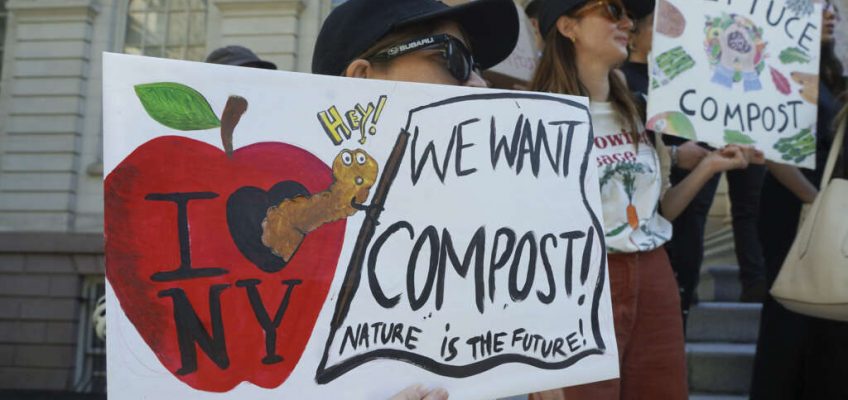“When people see the composting process up close—when they hold the finished product in their hands—they’re far more likely to separate their food scraps at home.”
A May 2024 rally outside City Hall against funding cuts to community composting programs. (Gerardo Romo / NYC Council Media Unit)
As the City Council debates the 2026 budget, there’s real concern that community composting could be eliminated—again. It happened in 2023. It could happen this year too.
That would be a huge mistake.
That’s because while New York City has finally made composting easy, the question remains: will people do it?
The city’s new curbside composting program—which was rolled out last fall but became mandatory for most residents beginning April 1—means New Yorkers can put food scraps and other food waste in a brown bin and set it out like they do their recycling. But infrastructure alone won’t make it a success.
Right now, participation is low. Only 4.6 percent of compostable materials are being diverted. That means 270,000 tons of food scraps were trashed in just the last quarter of 2024—wasted resources that could have enriched soil and cut emissions.
The problem isn’t access. It’s behavior. And behavior doesn’t change through mandates alone. New York has a chance to lead the way—not just by building the infrastructure, but by building the culture.
That’s where community composting comes in. These local programs don’t just process food scraps and create compost for city trees, parks, and gardens. They close the gap between policy and participation. When people see the composting process up close—when they hold the finished product in their hands—they’re far more likely to separate their food scraps at home.
This behavioral shift is critical: a study this year by the CUNY School of Public Health found that 85.8 percent of participants in community composting programs reported increased awareness of food waste, and 71.5 percent said they had reduced their household waste.
Community composting doesn’t compete with curbside composting—it fuels it. And the environment needs both types of composting now more than ever.
Food scraps in a landfill don’t just disappear—they rot, release methane, and add to the climate mess. Curbside compost largely turns food waste into biofuel. Community composting turns waste into rich, healthy soil that holds water, strengthens plants, and actually gives something back to the planet.
Combined, these composting efforts can cut greenhouse gas emissions in half. That’s the difference between keeping carbon in the soil or pumping methane into the air. If we’re looking for an easy climate win, this is it.
Unfortunately, community composting has been treated as expendable, despite its proven impact. In 2023, the Adams administration eliminated all funding, forcing small-scale composters to scrape by on private donations.
It took sustained advocacy—rallies, hearings, public pressure—for the City Council to restore $6.245 million in the last fiscal year budget.
But even with this victory, the funding shift underscores a troubling reality: community composting remains vulnerable. Unlike curbside composting, which has dedicated city resources, community-based programs constantly have to fight for their existence.
Yet these programs do what policy alone cannot—they educate, engage, and create the cultural shift necessary to make composting a habit. They also give residents an option. While the curbside program generates biofuel, community composting offers a truly circular system—one that regenerates soil and strengthens local ecosystems.
If New York is serious about reducing waste and cutting emissions, it must do more than save community composting from the budget axe. It must treat it as an essential part of our composting infrastructure, not an afterthought.
Christine Datz-Romero is the co-founder and executive director of the Lower East Side Ecology Center.
The post Opinion: Why NYC Needs Community Composting to Make Curbside Collections Work appeared first on City Limits.


Leave a Reply